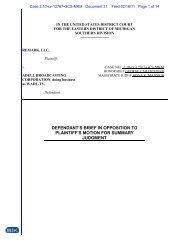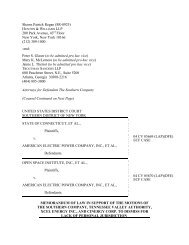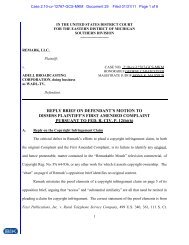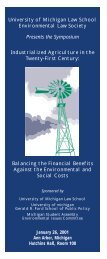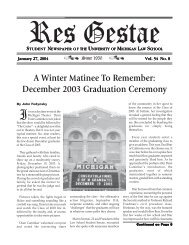Conn. v. American Electric, Memo in Support of Motion to Dismiss ...
Conn. v. American Electric, Memo in Support of Motion to Dismiss ...
Conn. v. American Electric, Memo in Support of Motion to Dismiss ...
Create successful ePaper yourself
Turn your PDF publications into a flip-book with our unique Google optimized e-Paper software.
UNITED STATES DISTRICT COURT<br />
SOUTHERN DISTRICT OF NEW YORK<br />
STATE OF CONNECTICUT, ET AL.,<br />
v.<br />
Pla<strong>in</strong>tiffs<br />
AMERICAN ELECTRIC POWER COMPANY, INC., ET AL.<br />
Defendants<br />
OPEN SPACE INSTITUTE, INC., ET AL.,<br />
v.<br />
Pla<strong>in</strong>tiffs<br />
AMERICAN ELECTRIC POWER COMPANY, INC., ET AL.<br />
Defendants<br />
:<br />
:<br />
:<br />
:<br />
:<br />
: 04 CV 05669 (LAP)(DFE)<br />
: ECF CASE<br />
:<br />
:<br />
:<br />
:<br />
:<br />
:<br />
:<br />
:<br />
:<br />
: 04 CV 05670 (LAP)(DFE)<br />
: ECF CASE<br />
:<br />
:<br />
:<br />
:<br />
MEMORANDUM OF LAW IN SUPPORT OF TENNESSEE VALLEY AUTHORITY’S<br />
MOTIONS TO DISMISS ON FEDERAL DISCRETIONARY FUNCTION GROUNDS<br />
September 30, 2004<br />
Office <strong>of</strong> the General Counsel<br />
Tennessee Valley Authority<br />
400 West Summit Hill Drive<br />
Knoxville, Tennessee 37902-1401<br />
Facsimile 865-632-6718<br />
Maureen H. Dunn<br />
General Counsel<br />
Harriet A. Cooper (HC4727)<br />
Assistant General Counsel<br />
Edw<strong>in</strong> W. Small (ES4418)<br />
Assistant General Counsel<br />
Frank H. Lancaster (FL4513)<br />
Todd L. Fulks (TF9072)<br />
At<strong>to</strong>rneys for Tennessee Valley Authority
TABLE OF CONTENTS<br />
Page<br />
STATEMENT..................................................................................................................................1<br />
Introduction ............................................................................................................................1<br />
TVA Is an Agency and Instrumentality <strong>of</strong> the United States................................................ 3<br />
TVA Is Charged by Statute With the Multipurpose Development <strong>of</strong> the Resources <strong>of</strong><br />
the Tennessee Valley Region. ............................................................................................... 6<br />
TVA’s Statu<strong>to</strong>rily Authorized Activities Include the Construction and Operation <strong>of</strong><br />
Fossil-Fired <strong>Electric</strong> Power Generat<strong>in</strong>g Facilities. ............................................................... 7<br />
In Mak<strong>in</strong>g Decisions About the Appropriate Generation Mix for its Power Program,<br />
TVA Considers and Balances Many Fac<strong>to</strong>rs, Includ<strong>in</strong>g Greenhouse Gas Emissions. ......... 8<br />
ARGUMENT.................................................................................................................................12<br />
Pla<strong>in</strong>tiffs’ Compla<strong>in</strong>ts Should be <strong>Dismiss</strong>ed as <strong>to</strong> TVA Because TVA’s Alleged<br />
Tortious Conduct Involves TVA’s Performance <strong>of</strong> Discretionary Functions<br />
Authorized by Federal Law................................................................................................. 12<br />
CONCLUSION..............................................................................................................................19<br />
i
UNITED STATES DISTRICT COURT<br />
SOUTHERN DISTRICT OF NEW YORK<br />
STATE OF CONNECTICUT, ET AL.,<br />
v.<br />
Pla<strong>in</strong>tiffs<br />
AMERICAN ELECTRIC POWER COMPANY, INC., ET AL.<br />
Defendants<br />
OPEN SPACE INSTITUTE, INC., ET AL.,<br />
v.<br />
Pla<strong>in</strong>tiffs<br />
AMERICAN ELECTRIC POWER COMPANY, INC., ET AL.<br />
Defendants<br />
:<br />
:<br />
:<br />
:<br />
:<br />
: 04 CV 05669 (LAP)(DFE)<br />
: ECF CASE<br />
:<br />
:<br />
:<br />
:<br />
:<br />
:<br />
:<br />
:<br />
:<br />
: 04 CV 05670 (LAP)(DFE)<br />
: ECF CASE<br />
:<br />
:<br />
:<br />
:<br />
MEMORANDUM OF LAW IN SUPPORT OF TENNESSEE VALLEY AUTHORITY’S<br />
MOTIONS TO DISMISS ON FEDERAL DISCRETIONARY FUNCTION GROUNDS<br />
STATEMENT<br />
Introduction<br />
Separate sets <strong>of</strong> Pla<strong>in</strong>tiffs have filed two virtually identical common law nuisance<br />
cases aga<strong>in</strong>st the same six Defendants, alleg<strong>in</strong>g that global warm<strong>in</strong>g is a nuisance; that carbon<br />
dioxide emissions from Defendants’ fossil-fired electric generat<strong>in</strong>g facilities contribute <strong>to</strong> the<br />
alleged nuisance; and that Defendants’ electrical generation based on fossil fuels should be<br />
reduced by judicial order. Defendant Tennessee Valley Authority (TVA), an agency and<br />
<strong>in</strong>strumentality <strong>of</strong> the United States, has moved <strong>to</strong> dismiss both cases on several grounds,<br />
1
<strong>in</strong>clud<strong>in</strong>g Federal discretionary function grounds. This memorandum <strong>of</strong> law is submitted <strong>in</strong><br />
support <strong>of</strong> TVA’s motions on Federal discretionary function grounds.<br />
In the first case (No. 04-CV-05669), the State <strong>of</strong> <strong>Conn</strong>ecticut, seven other states,<br />
and the City <strong>of</strong> New York allege that global warm<strong>in</strong>g is a public nuisance under Federal common<br />
law and under the separate laws <strong>of</strong> the states <strong>in</strong> which Defendants operate. In the second case<br />
(No. 04-CV-05670), three private entities allege that global warm<strong>in</strong>g is a public nuisance under<br />
Federal common law, and a public and private nuisance under the separate laws <strong>of</strong> the states<br />
where Defendants operate.<br />
As described <strong>in</strong> more detail below, TVA is an agency and <strong>in</strong>strumentality <strong>of</strong> the<br />
United States created by the TVA Act <strong>of</strong> 1933, and is charged by the TVA Act with carry<strong>in</strong>g out<br />
various Federal statu<strong>to</strong>ry functions, <strong>in</strong>clud<strong>in</strong>g the operation <strong>of</strong> Federal electric power generat<strong>in</strong>g<br />
facilities <strong>in</strong> the Tennessee Valley region. As alleged <strong>in</strong> the compla<strong>in</strong>ts, TVA operates fossil-fired<br />
electric power generat<strong>in</strong>g facilities <strong>in</strong> Alabama, Kentucky, Mississippi, and Tennessee.<br />
Pla<strong>in</strong>tiffs do not allege that TVA has violated any restrictions on carbon dioxide<br />
emissions under the Federal Clean Air Act or any other Federal statute or regula<strong>to</strong>ry scheme.<br />
Nor do Pla<strong>in</strong>tiffs allege that TVA has violated the TVA Act by utiliz<strong>in</strong>g fossil-fired facilities <strong>to</strong><br />
generate electric power <strong>in</strong> the Tennessee Valley region. Nevertheless, Pla<strong>in</strong>tiffs ask this Court <strong>to</strong><br />
exercise common law authority <strong>to</strong> dictate <strong>to</strong> TVA how <strong>to</strong> carry out its Federal statu<strong>to</strong>ry<br />
obligations.<br />
TVA’s position is that Pla<strong>in</strong>tiffs’ effort <strong>to</strong> have this Court sit as a common law<br />
regula<strong>to</strong>r <strong>of</strong> TVA’s statu<strong>to</strong>ry activities is legally precluded because the TVA Act vests authority<br />
and discretion <strong>in</strong> TVA’s Board <strong>of</strong> Direc<strong>to</strong>rs <strong>to</strong> conduct TVA’s statu<strong>to</strong>ry activities <strong>to</strong> accomplish<br />
the purposes <strong>of</strong> the TVA Act.<br />
2
TVA Is an Agency and Instrumentality <strong>of</strong> the United States.<br />
TVA is a constitutionally authorized 1 corporate agency and <strong>in</strong>strumentality <strong>of</strong> the<br />
United States, 2 created by and exist<strong>in</strong>g pursuant <strong>to</strong> the TVA Act <strong>of</strong> 1933, as amended, 16 U.S.C.<br />
1 See, e.g., Ashwander v. TVA, 297 U.S. 288, 338-39 (1936) (uphold<strong>in</strong>g TVA Act aga<strong>in</strong>st<br />
constitutional challenge relat<strong>in</strong>g <strong>to</strong> power sales by TVA); Goodpasture v. TVA, 434 F.2d 760,<br />
763 (6th Cir. 1970) (“The TVA Act is constitutional.”); United States ex rel. TVA v. Three Tracts<br />
<strong>of</strong> Land, Etc., 377 F. Supp. 631, 635 (N.D. Ala. 1974) (“It is the Court’s op<strong>in</strong>ion that the<br />
construction <strong>of</strong> a nuclear powered steam plant is authorized by the TVA Act and that the<br />
authorization is not <strong>in</strong> violation <strong>of</strong> the United States Constitution.”); United States ex rel. TVA v.<br />
An Easement & Right-<strong>of</strong>-Way Over Two Tracts <strong>of</strong> Land, Etc., 246 F. Supp. 263, 270 (W.D. Ky.<br />
1965) (“TVA’s . . . <strong>in</strong>tegrated system <strong>of</strong> multipurpose dams, steam plants, and transmission l<strong>in</strong>es,<br />
which <strong>to</strong>gether improve navigation, help control floods, produce power, and serve generally <strong>to</strong><br />
develop the Tennessee River watershed are authorized by the commerce clause <strong>of</strong> the<br />
Constitution . . . .”), aff’d “for the reasons stated and upon the authorities set forth <strong>in</strong> the op<strong>in</strong>ion<br />
<strong>of</strong> the district court,” 375 F.2d 120, 121 (6th Cir. 1967).<br />
2 See, e.g., 16 U.S.C. § 831r (2000) (denot<strong>in</strong>g TVA <strong>to</strong> be “an <strong>in</strong>strumentality and agency <strong>of</strong><br />
the Government <strong>of</strong> the United States”); Tenn. Elec. Power Co. v. TVA, 306 U.S. 118, 134 (1939)<br />
(referr<strong>in</strong>g <strong>to</strong> TVA as “an <strong>in</strong>strumentality <strong>of</strong> the United States”); Ashwander v. TVA, 297 U.S.<br />
288, 315 (1936) (referr<strong>in</strong>g <strong>to</strong> TVA as “an agency <strong>of</strong> the federal government”); Hill v. United<br />
States Dep’t <strong>of</strong> Labor, 65 F.3d 1331, 1333 (6th Cir. 1995) (TVA is “a wholly-owned corporate<br />
agency and <strong>in</strong>strumentality <strong>of</strong> the United States . . . .”); Spr<strong>in</strong>ger v. Bryant, 897 F.2d 1085, 1089<br />
(11th Cir. 1990) (“The TVA is a federally owned corporation that acts as an agency or<br />
<strong>in</strong>strumentality <strong>of</strong> the United States.”); TVA v. K<strong>in</strong>zer, 142 F.2d 833, 837 (6th Cir. 1944) (“It<br />
[TVA] is pla<strong>in</strong>ly a governmental agency or <strong>in</strong>strumentality <strong>of</strong> the United States.”); Posey v. TVA,<br />
93 F.2d 726, 727 (5th Cir. 1937) (“[T]he Authority is pla<strong>in</strong>ly a governmental agency <strong>of</strong> the<br />
United States . . . .”).<br />
Because TVA is an agency <strong>of</strong> the United States, its employees are Federal employees<br />
(see, e.g., Jones v. TVA, 948 F.2d 258, 262 (6th Cir. 1991) (“Jones was a federal employee<br />
dur<strong>in</strong>g his tenure with TVA.”); Hill v. TVA, 842 F. Supp. 1413, 1416 n.2 (N.D. Ala. 1993)<br />
(“TVA employees are regarded as federal employees <strong>in</strong> the excepted service under [the Civil<br />
Service Reform Act].”); McNabb v. TVA, 754 F. Supp. 118, 120 (E.D. Tenn. 1990)<br />
(“McNabb was a federal employee when he worked for TVA.”)), and they are entitled <strong>to</strong><br />
federal <strong>of</strong>ficial immunity. See, e.g., Quality Tech. Co. v. S<strong>to</strong>ne & Webster Engg. Co., 745 F.<br />
Supp. 1331, 1343 (E.D. Tenn. 1989) (hold<strong>in</strong>g TVA’s manager <strong>of</strong> nuclear power <strong>to</strong> be entitled <strong>to</strong><br />
Federal <strong>of</strong>ficial immunity), aff’d, 909 F.2d 1484 (6th Cir. 1990); Johns v. Pettibone Corp.,<br />
843 F.2d 464, 466-67 (11th Cir. 1988) (affirm<strong>in</strong>g district court hold<strong>in</strong>g that the defendant TVA<br />
employees, six managers and supervisors <strong>in</strong> power production and construction, were entitled <strong>to</strong><br />
Federal <strong>of</strong>ficial immunity).<br />
3
§§ 831-831ee (2000 & Supp. II 2002), with authority under 16 U.S.C. § 831c(b) <strong>to</strong> sue and be<br />
sued <strong>in</strong> its own name. Under the TVA Act, TVA is charged with the multipurpose development<br />
<strong>of</strong> the resources <strong>of</strong> the Tennessee Valley region for the public good, 3 and has been granted broad<br />
statu<strong>to</strong>ry powers <strong>to</strong> carry out its mission. 4 TVA’s activities, <strong>in</strong>clud<strong>in</strong>g its electric power program<br />
activities, are widely known and judicially noticeable, 5 and, as a matter <strong>of</strong> Federal law, TVA’s<br />
authorized activities under the TVA Act are wholly governmental <strong>in</strong> nature. 6<br />
3 The purposes <strong>of</strong> the TVA Act are broad and <strong>in</strong>clude not only the production, distribution,<br />
and sale <strong>of</strong> electric power at rates as low as are feasible (16 U.S.C. §§ 831d(l), 831n-4(f)), but<br />
also “the advancement <strong>of</strong> the national defense and the physical, social and economic<br />
development” <strong>of</strong> the Tennessee Valley (id. § 831n-4(h)), “agricultural and <strong>in</strong>dustrial<br />
development” (id. § 831), improvement <strong>of</strong> navigation (id.), control <strong>of</strong> flood waters (id.), law<br />
enforcement (id. § 831c-3), and economic development (id. § 831u). Further, the TVA Act is <strong>to</strong><br />
be “liberally construed <strong>to</strong> carry out the purposes <strong>of</strong> Congress <strong>to</strong> . . . provide for the national<br />
defense, improve navigation, control destructive floods, and promote <strong>in</strong>terstate commerce and<br />
the general welfare.” Id. § 831dd.<br />
4 For example, TVA is authorized <strong>to</strong> condemn property <strong>in</strong> the name <strong>of</strong> the United States <strong>to</strong><br />
carry out the purposes <strong>of</strong> the TVA Act. See 16 U.S.C. §§ 831c(h) (TVA “[s]hall have power <strong>in</strong><br />
the name <strong>of</strong> the United States <strong>of</strong> America <strong>to</strong> exercise the right <strong>of</strong> em<strong>in</strong>ent doma<strong>in</strong> . . . .”). See<br />
also 16 U.S.C. § 831c(g) (2000) (TVA “[s]hall have such powers as may be necessary or<br />
appropriate for the exercise <strong>of</strong> the powers here<strong>in</strong> specifically conferred upon [TVA].”).<br />
5 See United States ex rel. TVA v. An Easement & Right-<strong>of</strong>-Way, Etc., 246 F. Supp. 263,<br />
269 (W.D. Ky. 1965) (“The basic facts as <strong>to</strong> the activities <strong>of</strong> TVA, <strong>in</strong>clud<strong>in</strong>g the development <strong>of</strong><br />
its power program and other statu<strong>to</strong>ry programs, are matters <strong>of</strong> public record and common<br />
knowledge; they are conta<strong>in</strong>ed <strong>in</strong> TVA’s annual reports <strong>to</strong> Congress and are judicially known <strong>to</strong><br />
the Court.”), aff’d, 375 F.2d 120 (6th Cir. 1967).<br />
6 Contrary <strong>to</strong> the rule <strong>of</strong>ten applied under state law <strong>to</strong> state and local government agencies,<br />
the authorized activities <strong>of</strong> Federal <strong>in</strong>strumentalities through which the Federal government acts<br />
are wholly governmental and cannot be parsed <strong>in</strong><strong>to</strong> governmental and non-governmental<br />
categories. See Fed. Land Bank v. Bd. <strong>of</strong> County Comm’rs, 368 U.S. 146, 150-51 (1961) (“[O]ur<br />
decisions have made it clear that the Federal Government performs no ‘proprietary’ functions. If<br />
the enabl<strong>in</strong>g Act is constitutional and if the <strong>in</strong>strumentality’s activity is with<strong>in</strong> the authority<br />
granted by the Act, a governmental function is be<strong>in</strong>g performed.”); Fed. Crop Ins. Corp. v.<br />
Merrill, 332 U.S. 380, 383-84 (1947) (“Government is not partly public or partly private,<br />
depend<strong>in</strong>g upon the governmental pedigree <strong>of</strong> the type <strong>of</strong> a particular activity or the manner <strong>in</strong><br />
which the Government conducts it.”); Fed. Land Bank v. Bismarck Lumber Co., 314 U.S. 95,<br />
4
The authority <strong>to</strong> exercise all <strong>of</strong> TVA’s statu<strong>to</strong>ry powers is vested <strong>in</strong> TVA’s Board<br />
<strong>of</strong> Direc<strong>to</strong>rs by 16 U.S.C. § 831a(g). The TVA Board, by statute, is composed <strong>of</strong> three United<br />
States citizens appo<strong>in</strong>ted by the President for n<strong>in</strong>e-year terms by and with the advice and consent<br />
<strong>of</strong> the Senate. See 16 U.S.C. § 831a(a)-(e). As required by 16 U.S.C. § 831h(a), the TVA Board<br />
submits annual reports <strong>to</strong> the President and Congress about TVA’s activities. 7<br />
(. . . cont<strong>in</strong>ued)<br />
102 (1941) (“[W]hen Congress constitutionally creates a corporation through which the federal<br />
government lawfully acts, the activities <strong>of</strong> such corporation are governmental.”); Pittman v.<br />
Home Owners’ Loan Corp., 308 U.S. 21, 32 (1939) (“[T]he activities <strong>of</strong> the Corporation through<br />
which the national government lawfully acts must be regarded as governmental functions . . . .”);<br />
Graves v. New York ex rel. O’Keefe, 306 U.S. 466, 477 (1939) (“[W]hen the national<br />
government lawfully acts through a corporation which it owns and controls, those activities are<br />
governmental functions . . . .”). See also Garcia v. San An<strong>to</strong>nio Metro. Transit Auth., 469 U.S.<br />
528, 545 (1985) (“The goal <strong>of</strong> identify<strong>in</strong>g ‘uniquely’ governmental functions . . . has been<br />
rejected by the Court <strong>in</strong> the field <strong>of</strong> government <strong>to</strong>rt liability <strong>in</strong> part because the notion <strong>of</strong> a<br />
‘uniquely’ governmental function is unmanageable.”).<br />
Thus, the authorized activities <strong>of</strong> TVA are wholly governmental. See, e.g., In re<br />
Agricultural Bus<strong>in</strong>ess Co., 613 F.2d 783, 787 (10th Cir. 1980) (“[T]he TVA is the United States<br />
<strong>in</strong> action, ‘an arm <strong>of</strong> the government,’ and an agency perform<strong>in</strong>g wholly governmental service.”)<br />
(citation omitted); Quality Tech. v. S<strong>to</strong>ne & Webster Engg., 745 F. Supp. 1331, 1339 (E.D. Tenn.<br />
1989) (“As has been declared by many courts, the TVA is a federal government corporation —<br />
‘an agency perform<strong>in</strong>g wholly governmental services, and is an <strong>in</strong>strumentality <strong>of</strong> the United<br />
States.’”), aff’d, 909 F.2d 1484 (6th Cir. 1990); Gold Po<strong>in</strong>t Mar<strong>in</strong>a, Inc. v. TVA, 635 F. Supp. 39,<br />
42 (E.D. Tenn. 1986) (“TVA is an agency perform<strong>in</strong>g wholly governmental services . . . .”); PRI<br />
Pipe <strong>Support</strong>s v. TVA, 494 F. Supp. 974, 975 (N.D. Miss. 1980) (“TVA is an agency perform<strong>in</strong>g<br />
wholly governmental services . . . .”); TVA v. United States Carbon Prods., Inc., 427 F. Supp.<br />
474, 477 (E.D. Ill. 1976) (“TVA is . . . an agency perform<strong>in</strong>g wholly governmental services.”);<br />
TVA v. Mason Coal, Inc., 384 F. Supp. 1107, 1115 (E.D. Tenn. 1974) (“TVA is an ‘arm <strong>of</strong> the<br />
[federal] government’ and an agency perform<strong>in</strong>g wholly governmental services.”) (alteration <strong>in</strong><br />
orig<strong>in</strong>al), aff’d, 513 F.2d 632 (6th Cir. 1975); Knickerbocker v. TVA, 348 F. Supp. 230, 232<br />
(E.D. Ill. 1972) (“TVA is . . . an agency perform<strong>in</strong>g wholly governmental service.”); Ramsey v.<br />
United M<strong>in</strong>e Workers <strong>of</strong> Am., 27 F.R.D. 423, 425 (E.D. Tenn. 1961) (“Actually the TVA is the<br />
United States <strong>in</strong> action, ‘an arm <strong>of</strong> the government’, and an agency perform<strong>in</strong>g wholly<br />
governmental service.”).<br />
7 TVA’s Annual Reports about its activities are subject <strong>to</strong> judicial notice. See Ill. Cent.<br />
R. R. Co. v. TVA, 445 F.2d 308, 310 n.4 (6th Cir. 1971); Mobil Oil Corp. v. TVA, 387 F. Supp.<br />
498, 500 n.1 (N.D. Ala. 1974).<br />
5
TVA Is Charged by Statute With the Multipurpose Development<br />
<strong>of</strong> the Resources <strong>of</strong> the Tennessee Valley Region.<br />
Under the TVA Act, TVA is charged with broad responsibilities for the<br />
multipurpose development <strong>of</strong> the Tennessee Valley region. As the Supreme Court stated <strong>in</strong><br />
United States ex rel. TVA v. Welch, 327 U.S. 546, 553 (1946):<br />
The broad responsibilities placed on the Authority [by the TVA Act] relate <strong>to</strong><br />
navigability, flood control, reforestation, marg<strong>in</strong>al lands, and agricultural<br />
and <strong>in</strong>dustrial development <strong>of</strong> the whole Tennessee Valley. The T.V.A. was<br />
empowered <strong>to</strong> make contracts, purchase and sell property deemed necessary or<br />
convenient <strong>in</strong> the transaction <strong>of</strong> its bus<strong>in</strong>ess, and <strong>to</strong> build dams, reservoirs,<br />
transmission l<strong>in</strong>es, power houses, and other structures. . . . All <strong>of</strong> the<br />
Authority’s actions <strong>in</strong> these respects were <strong>to</strong> be directed <strong>to</strong>wards<br />
“development <strong>of</strong> the natural resources <strong>of</strong> the Tennessee River dra<strong>in</strong>age bas<strong>in</strong><br />
and <strong>of</strong> such adjo<strong>in</strong><strong>in</strong>g terri<strong>to</strong>ry as may be related <strong>to</strong> or materially affected by<br />
the development consequent <strong>to</strong> this Act . . . all for the general purpose <strong>of</strong><br />
foster<strong>in</strong>g an orderly and proper physical, economic, and social development<br />
<strong>of</strong> said areas . . .” To discharge its responsibilities the T.V.A. was granted “such<br />
powers as may be necessary or appropriate” for their exercise. 8<br />
Three <strong>of</strong> TVA’s major multipurpose development programs are <strong>in</strong> the areas <strong>of</strong><br />
electric power, river operations, and land management. These programs were recently<br />
summarized <strong>in</strong> the Federal Register:<br />
TVA is a multipurpose federal corporation with a mandate <strong>to</strong> foster<br />
the social and economic well-be<strong>in</strong>g <strong>of</strong> the residents <strong>of</strong> the Tennessee Valley<br />
region through the wise use, conservation, and development <strong>of</strong> its natural<br />
resources. In carry<strong>in</strong>g out this mission, TVA conducts a range <strong>of</strong> programs<br />
and activities, <strong>in</strong>clud<strong>in</strong>g operat<strong>in</strong>g the Nation’s largest public power system,<br />
serv<strong>in</strong>g almost n<strong>in</strong>e million people <strong>in</strong> parts <strong>of</strong> seven southeastern states, and<br />
operat<strong>in</strong>g a system <strong>of</strong> dams and reservoirs with associated facilities--its water<br />
control system.<br />
As directed by the TVA Act, TVA manages the Tennessee River and<br />
reservoir system as an <strong>in</strong>tegrated water control system primarily for the purposes<br />
<strong>of</strong> navigation, flood control, and power production. Consistent with those<br />
purposes, TVA operates the system <strong>to</strong> improve water quality and water supply,<br />
8 Emphasis added above and throughout this memorandum unless noted otherwise.<br />
6
and provide recreational opportunities, and a wide range <strong>of</strong> other public benefits.<br />
The water control system has hydroelectric genera<strong>to</strong>rs and provides the cool<strong>in</strong>g<br />
water supply for TVA’s coal-fired and nuclear power plants and water supply for<br />
other <strong>in</strong>dustries located adjacent <strong>to</strong> the reservoirs. TVA’s power system and its<br />
management <strong>of</strong> the <strong>in</strong>tegrated water control system are central components <strong>of</strong> the<br />
economic well-be<strong>in</strong>g <strong>of</strong> the Tennessee Valley region.<br />
TVA also manages 11,000 miles <strong>of</strong> public shorel<strong>in</strong>e <strong>to</strong> ma<strong>in</strong>ta<strong>in</strong> the<br />
<strong>in</strong>tegrity <strong>of</strong> the reservoir system. TVA has cus<strong>to</strong>dy <strong>of</strong> and manages 293,000 acres<br />
<strong>of</strong> land <strong>in</strong> the Valley, most <strong>of</strong> which is along the shorel<strong>in</strong>es <strong>of</strong> TVA reservoirs.<br />
69 Fed. Reg. 30,975 (June 1, 2004) (Issuance <strong>of</strong> Record <strong>of</strong> Decision, F<strong>in</strong>al Programmatic<br />
Environmental Impact Statement, Tennessee Valley Authority Reservoir Operations Study (TVA<br />
2004)).<br />
The TVA Act at 16 U.S.C. § 831d(l) authorizes the TVA Board <strong>to</strong> “produce,<br />
distribute, and sell electric power” as part <strong>of</strong> its multipurpose development activities; and, <strong>in</strong><br />
accordance with that statu<strong>to</strong>ry authority, TVA operates a large electric power generat<strong>in</strong>g and<br />
transmission system. That system was described <strong>in</strong> 4-County Elec. Power Ass’n v. TVA, 930 F.<br />
Supp. 1132, 1135 (S.D. Miss. 1996):<br />
TVA, a federal agency organized and exist<strong>in</strong>g under the TVA Act, 16 U.S.C.<br />
§ 831l-831dd, ma<strong>in</strong>ta<strong>in</strong>s and operates one <strong>of</strong> the nation’s largest electric<br />
power systems as part <strong>of</strong> a program <strong>to</strong> fulfill its mission for the development<br />
<strong>of</strong> the Tennessee Valley region’s resources and economy. It produces and sells<br />
electricity <strong>to</strong> 160 municipal and cooperative distribu<strong>to</strong>rs for millions <strong>of</strong><br />
residential, commercial, <strong>in</strong>dustrial and governmental cus<strong>to</strong>mers, and also sells<br />
electricity directly <strong>to</strong> a number <strong>of</strong> <strong>in</strong>dustrial cus<strong>to</strong>mers with large or unusual loads<br />
and several federal agency <strong>in</strong>stallations. The area <strong>in</strong> which TVA supplies power<br />
covers about 80,000 square miles, which <strong>in</strong>cludes most <strong>of</strong> Tennessee, northern<br />
Alabama, northeastern Mississippi, southwestern Kentucky and parts <strong>of</strong> Georgia,<br />
North Carol<strong>in</strong>a and Virg<strong>in</strong>ia, and has a population <strong>of</strong> over 8,000,000.<br />
TVA’s Statu<strong>to</strong>rily Authorized Activities Include the Construction and<br />
Operation <strong>of</strong> Fossil-Fired <strong>Electric</strong> Power Generat<strong>in</strong>g Facilities.<br />
TVA’s authorized power program activities specifically <strong>in</strong>clude the construction<br />
and operation <strong>of</strong> steam plants such as TVA’s coal-fired steam plants about which Pla<strong>in</strong>tiffs<br />
7
compla<strong>in</strong>. 9 In Ra<strong>in</strong>bow Realty Co. v. TVA, 124 F. Supp. 436, 439-40 (M.D. Tenn. 1954), <strong>in</strong><br />
hold<strong>in</strong>g that TVA had authority under the TVA Act <strong>to</strong> construct steam plants, the court po<strong>in</strong>ted<br />
out that Congress had made appropriations <strong>to</strong> TVA for the construction <strong>of</strong> eight coal-fired steam<br />
plants:<br />
Appropriation Acts <strong>of</strong> Congress have provided funds for eight major<br />
steam plants now constructed or <strong>in</strong> process <strong>of</strong> construction by T.V.A.: 54 Stat.<br />
781, cover<strong>in</strong>g Watts Bar Steamplant; 63 Stat. 76, 80, cover<strong>in</strong>g Johnsonville;<br />
64 Stat. 37-38, cover<strong>in</strong>g Widows Creek; 64 Stat. 1223, 1229, cover<strong>in</strong>g K<strong>in</strong>gs<strong>to</strong>n<br />
and Shawnee Steamplants; 65 Stat. 268, 280, cover<strong>in</strong>g Colbert; and 66 Stat. 637,<br />
645, cover<strong>in</strong>g the Gallat<strong>in</strong> and John Sevier Steamplants. These repeated<br />
congressional appropriations <strong>in</strong>dicate clearly the <strong>in</strong>terpretation by Congress<br />
<strong>of</strong> the T.V.A. Act <strong>to</strong> authorize construction <strong>of</strong> steamplants.<br />
See also United States ex rel. TVA v. Three Tracts <strong>of</strong> Land, Etc., 377 F. Supp. 631, 634 (N.D.<br />
Ala. 1974) (“16 U.S.C. § 831n and § 831n-4, <strong>in</strong>dicate that steam plants are <strong>to</strong> be constructed by<br />
TVA when they become necessary <strong>to</strong> discharge TVA’s broad responsibilities for the<br />
advancement <strong>of</strong> the national defense and the physical, social and economic development <strong>of</strong> the<br />
area and Congress further <strong>in</strong>tends that TVA should provide an ample supply <strong>of</strong> electric power for<br />
such purposes.”).<br />
In Mak<strong>in</strong>g Decisions About the Appropriate Generation Mix for its<br />
Power Program, TVA Considers and Balances Many Fac<strong>to</strong>rs,<br />
Includ<strong>in</strong>g Greenhouse Gas Emissions.<br />
TVA is well aware that burn<strong>in</strong>g coal and natural gas at TVA plants results <strong>in</strong><br />
carbon dioxide emissions and that carbon dioxide is a greenhouse gas. TVA also is well aware<br />
9 TVA generates the bulk <strong>of</strong> the electricity needed for its power program through its<br />
operation <strong>of</strong> 11 coal-fired steam plants (59 units), 3 nuclear steam plants (5 units),<br />
29 hydroelectric plants (109 units), and 6 combustion turb<strong>in</strong>e plants (72 units) (TVA’s 2003<br />
Annual Report <strong>in</strong>side cover, 17; available at http://www.tva.gov/f<strong>in</strong>ance/reports/pdf/<br />
TVA2003_annual_report.pdf). Lesser amounts <strong>of</strong> electric power are supplied by TVA’s<br />
operation <strong>of</strong> 15 solar energy sites, a w<strong>in</strong>d energy site (3 turb<strong>in</strong>es), and a pumped s<strong>to</strong>rage plant<br />
(4 units) (id.). Some amounts also are purchased from other entities.<br />
8
<strong>of</strong> the scientific research relat<strong>in</strong>g <strong>to</strong> greenhouse gases and global warm<strong>in</strong>g. Indeed, <strong>in</strong><br />
conduct<strong>in</strong>g its power program, TVA has taken, and is tak<strong>in</strong>g, actions it considers appropriate<br />
based on that research and on the potential for harm from carbon dioxide emissions. However,<br />
<strong>in</strong> mak<strong>in</strong>g judgments about what actions <strong>to</strong> take based on the potential for harm from carbon<br />
dioxide emissions, TVA necessarily balances compet<strong>in</strong>g social, economic, and political policies<br />
<strong>in</strong> order <strong>to</strong> carry out its statu<strong>to</strong>ry missions <strong>of</strong> provid<strong>in</strong>g low-cost reliable electric power while<br />
also protect<strong>in</strong>g the environment and support<strong>in</strong>g economic development. The fact that TVA<br />
balances these disparate <strong>in</strong>terests is a matter <strong>of</strong> public record which is documented <strong>in</strong> detail <strong>in</strong><br />
various Government publications, <strong>in</strong>clud<strong>in</strong>g three TVA environmental impact statements issued<br />
<strong>in</strong> the last decade related <strong>to</strong> TVA’s power program: Energy Vision 2020, Integrated Resource<br />
Plan/Environmental Impact Statement (TVA 1995); F<strong>in</strong>al Supplemental Environmental Impact<br />
Statement for Operat<strong>in</strong>g License Renewal <strong>of</strong> the Browns Ferry Nuclear Plant <strong>in</strong> Athens,<br />
Alabama (TVA 2002); F<strong>in</strong>al Programmatic Environmental Impact Statement, Tennessee Valley<br />
Authority Reservoir Operations Study (TVA 2004). 10<br />
TVA’s Energy Vision 2020 EIS <strong>in</strong>volved TVA’s consideration <strong>of</strong> a wide range <strong>of</strong><br />
resource alternatives for meet<strong>in</strong>g electric power needs. See 61 Fed. Reg. 7,572 (Feb. 28, 1996)<br />
(Issuance <strong>of</strong> Record <strong>of</strong> Decision). TVA’s long-term goal was “viewed as not only ma<strong>in</strong>ta<strong>in</strong><strong>in</strong>g<br />
low electric rates and reliable service, but also foster<strong>in</strong>g susta<strong>in</strong>able economic development and<br />
10 As a Federal agency, TVA is subject <strong>to</strong> the National Environmental Policy Act (NEPA),<br />
42 U.S.C. §§ 4321-4370f (2000), which requires Federal agencies <strong>to</strong> consider the environmental<br />
effects <strong>of</strong> major Federal actions which are likely <strong>to</strong> have a significant effect on the quality <strong>of</strong> the<br />
human environment. For major Federal actions with significant environmental impacts, NEPA<br />
requires agencies <strong>to</strong> prepare and issue Environmental Impact Statements.<br />
9
protect<strong>in</strong>g environmental quality” and the decision process “<strong>in</strong>tegrated economic development<br />
and environmental goals.” Id. at 7,573-7,574. As summarized <strong>in</strong> the Record <strong>of</strong> Decision:<br />
Id. at 7,573.<br />
The primary analytical method used for Energy Vision 2020 was the<br />
multi-attribute trade<strong>of</strong>f method. This approach allowed TVA <strong>to</strong><br />
quantitatively <strong>in</strong>tegrate the identified environmental impacts <strong>of</strong> proposed<br />
energy resource strategies and <strong>to</strong> formulate alternative strategies <strong>to</strong> mitigate<br />
adverse environmental impacts while reta<strong>in</strong><strong>in</strong>g other beneficial<br />
characteristics <strong>of</strong> specific strategies.<br />
Energy resource strategies are created from different comb<strong>in</strong>ations <strong>of</strong><br />
energy resource options. Energy resource options are either supply-side options<br />
(e.g., new generat<strong>in</strong>g resources such as coal-fired or nuclear units, gas-fired<br />
combustion turb<strong>in</strong>es, repower<strong>in</strong>g <strong>of</strong> exist<strong>in</strong>g units, <strong>in</strong>tegrated gasification, or w<strong>in</strong>d<br />
turb<strong>in</strong>es), or cus<strong>to</strong>mer service options (e.g., demand-side management actions,<br />
<strong>in</strong>clud<strong>in</strong>g energy efficiency improvements and energy conservation, or beneficial<br />
electrification). . . .<br />
TVA developed 2,000 energy resource strategies from more than 100<br />
supply-side and 60 cus<strong>to</strong>mer service options. These strategies were then analyzed<br />
through the use <strong>of</strong> computer models <strong>to</strong> identify comb<strong>in</strong>ations <strong>of</strong> resource options<br />
that best met the evaluation criteria . . . .<br />
The multi-attribute trade<strong>of</strong>f method allowed potential environmental<br />
impacts <strong>of</strong> each strategy <strong>to</strong> be compared <strong>to</strong> all other evaluation criteria (such as<br />
debt, electric rates, and economic development) and <strong>to</strong> all other strategies on an<br />
objective basis. This process identified where real trade<strong>of</strong>fs existed. One <strong>of</strong> the<br />
most important trade<strong>of</strong>fs occurred between better environmental performance and<br />
electric rates because achiev<strong>in</strong>g better environmental performance typically<br />
produces higher costs and higher electric rates. However, the <strong>in</strong>tegrated resource<br />
plann<strong>in</strong>g process used by TVA allowed it <strong>to</strong> reformulate strategies repeatedly <strong>to</strong><br />
produce strategies that performed better across all criteria, <strong>in</strong>clud<strong>in</strong>g<br />
environmental criteria. . . . Eventually this <strong>in</strong>tegration process produced seven<br />
f<strong>in</strong>al alternative strategies that performed well across all <strong>of</strong> the criteria, <strong>in</strong>clud<strong>in</strong>g<br />
environmental criteria.<br />
The TVA Board adopted the EIS’s preferred alternative (the portfolio<br />
alternative—a blend <strong>of</strong> the seven f<strong>in</strong>al alternatives) at its February 26, 1996, public meet<strong>in</strong>g,<br />
f<strong>in</strong>d<strong>in</strong>g that “TVA’s preferred portfolio alternative better enables TVA <strong>to</strong> meet cus<strong>to</strong>mer needs at<br />
an acceptable level <strong>of</strong> risk and still meet the objectives <strong>of</strong> balanc<strong>in</strong>g costs, rates, environmental<br />
10
impacts, debt, and economic development.” Id. at 7,574. One <strong>of</strong> the fac<strong>to</strong>rs utilized <strong>in</strong><br />
consider<strong>in</strong>g the alternatives was greenhouse gas emissions. As noted <strong>in</strong> the Record <strong>of</strong> Decision:<br />
Id.<br />
[G]reenhouse gas emissions from the TVA system are projected <strong>to</strong> <strong>in</strong>crease under<br />
all strategies by 25 <strong>to</strong> 38 percent. This <strong>in</strong>crease is still less than that projected for<br />
the no-action alternative (it results <strong>in</strong> a 52-percent <strong>in</strong>crease) and on a per unit <strong>of</strong><br />
electric energy basis produced 10 <strong>to</strong> 15 percent less than that produced by the<br />
exist<strong>in</strong>g system. This means that the efficiency <strong>of</strong> the TVA system is improved<br />
under the f<strong>in</strong>al seven alternatives.<br />
The Browns Ferry License Renewal EIS <strong>in</strong>volved the TVA Board’s May 16,<br />
2002, decision <strong>to</strong> refurbish and restart Browns Ferry Nuclear Unit 1 and <strong>to</strong> seek operat<strong>in</strong>g license<br />
extensions for all three Browns Ferry nuclear units. See 67 Fed. Reg. 41,565 (June 18, 2002)<br />
(Issuance <strong>of</strong> Record <strong>of</strong> Decision). Aga<strong>in</strong>, the impact <strong>of</strong> greenhouse gas emissions was<br />
considered. As noted <strong>in</strong> the Record <strong>of</strong> Decision:<br />
Id. at 41,568.<br />
On May 16, 2002, the TVA Board <strong>of</strong> Direc<strong>to</strong>rs decided <strong>to</strong> adopt the<br />
preferred alternative (Alternative 2) <strong>to</strong> refurbish and restart BFN Unit 1, and <strong>to</strong><br />
proceed with NRC license extensions for all three units at BFN. This decision<br />
<strong>to</strong>ok <strong>in</strong><strong>to</strong> account environmental considerations <strong>to</strong>gether with economic and<br />
technical aspects <strong>of</strong> the project. Proceed<strong>in</strong>g with license extensions and Unit 1<br />
restart is the best bus<strong>in</strong>ess decision for TVA and the Tennessee Valley <strong>in</strong> terms <strong>of</strong><br />
power supply, power price, generation mix, return on <strong>in</strong>vestment, and avoidance<br />
<strong>of</strong> environmental impacts. This decision has the three-fold benefits <strong>of</strong> assur<strong>in</strong>g<br />
future power supplies without the environmental effects result<strong>in</strong>g from operation<br />
<strong>of</strong> fossil fuel generat<strong>in</strong>g plants (<strong>in</strong>clud<strong>in</strong>g <strong>in</strong>creased emissions <strong>of</strong> greenhouse<br />
gases), avoid<strong>in</strong>g the even larger capital outlays associated with new construction,<br />
and avoid<strong>in</strong>g the environmental impacts result<strong>in</strong>g from sit<strong>in</strong>g and construction <strong>of</strong><br />
new power plant generat<strong>in</strong>g facilities.<br />
F<strong>in</strong>ally, the Reservoir Operations Study EIS <strong>in</strong>volved proposed changes <strong>in</strong> the<br />
way that TVA operates its reservoir system. 69 Fed. Reg. 30,975 (June 1, 2004) (Issuance <strong>of</strong><br />
Record <strong>of</strong> Decision). The TVA Board adopted the EIS’s preferred alternative (the blended<br />
alternative) at its May 19, 2004, public meet<strong>in</strong>g. Id. Because an <strong>in</strong>crease or decrease <strong>in</strong> hydro<br />
11
generation can impact the amount <strong>of</strong> generation needed from fossil fuels, the effect <strong>of</strong> TVA’s<br />
action on greenhouse gas emissions aga<strong>in</strong> was considered. As noted <strong>in</strong> the Record <strong>of</strong> Decision<br />
discussion regard<strong>in</strong>g the Commercial Navigation Alternative:<br />
Id. at 30,978.<br />
TVA has concluded that the Commercial Navigation Alternative, with its m<strong>in</strong>or<br />
changes <strong>in</strong> water availability limited primarily <strong>to</strong> ma<strong>in</strong>stream reservoirs, has<br />
slightly better environmental consequences than the Base Case and Preferred<br />
Alternative and is the environmentally preferable alternative. . . . It would<br />
provide beneficial effects on greenhouse gas emissions . . . .<br />
ARGUMENT<br />
Pla<strong>in</strong>tiffs’ Compla<strong>in</strong>ts Should be <strong>Dismiss</strong>ed as <strong>to</strong> TVA Because TVA’s<br />
Alleged Tortious Conduct Involves TVA’s Performance <strong>of</strong><br />
Discretionary Functions Authorized by Federal Law.<br />
It is a fundamental tenet <strong>of</strong> Federal law that the performance by Federal agencies<br />
<strong>of</strong> discretionary functions entrusted <strong>to</strong> them by statute is not subject <strong>to</strong> judicial review by way <strong>of</strong><br />
a <strong>to</strong>rt suit for damages or for an <strong>in</strong>junction. As the Second Circuit stated <strong>in</strong> In re Jo<strong>in</strong>t E. and S.<br />
Districts Asbes<strong>to</strong>s Litig., 891 F.2d 31, 35 (2d Cir. 1989):<br />
The wellspr<strong>in</strong>g <strong>of</strong> the discretionary function exception is the doctr<strong>in</strong>e <strong>of</strong><br />
separation <strong>of</strong> powers. Simply stated, pr<strong>in</strong>ciples <strong>of</strong> separation <strong>of</strong> powers mandate<br />
that the judiciary refra<strong>in</strong> from decid<strong>in</strong>g questions consigned <strong>to</strong> the concurrent<br />
branches <strong>of</strong> the government [citation omitted]. If substantial constitutional issues<br />
are not implicated, the wisdom <strong>of</strong> decisions made by the executive and legislative<br />
branches are not subject <strong>to</strong> judicial review [citations omitted].<br />
Under the Federal discretionary function doctr<strong>in</strong>e, conduct <strong>of</strong> a Federal agency<br />
challenged <strong>in</strong> a <strong>to</strong>rt suit is not subject <strong>to</strong> review if (1) there is no manda<strong>to</strong>ry Federal statute,<br />
regulation or policy which controls the matter, and (2) the alleged <strong>to</strong>rtious conduct is susceptible<br />
<strong>to</strong> policy analysis. See, e.g., In re Jo<strong>in</strong>t E. and S. Districts Asbes<strong>to</strong>s Litig., 891 F.2d at 36-37;<br />
Brotman v. United States, 111 F. Supp. 2d 418, 423, 425 (S.D.N.Y. 2000). Here, Pla<strong>in</strong>tiffs have<br />
not alleged that TVA’s challenged conduct violates any Federal statute, regulation, or policy that<br />
12
dictates a specific course <strong>of</strong> action, even though the burden <strong>of</strong> alleg<strong>in</strong>g and mak<strong>in</strong>g such a<br />
show<strong>in</strong>g is on Pla<strong>in</strong>tiffs. See, e.g., Brotman v. United States, 111 F. Supp 2d at 423 (“The<br />
[pla<strong>in</strong>tiffs] have the burden <strong>of</strong> show<strong>in</strong>g that the challenged action <strong>of</strong> [the Government agency]<br />
was not discretionary but was <strong>in</strong>stead ‘controlled by manda<strong>to</strong>ry statutes or regulations.’”).<br />
Absent an allegation that TVA’s carbon dioxide emissions violate a manda<strong>to</strong>ry Federal statute or<br />
regulation which controls the matter (and <strong>to</strong> TVA’s knowledge no such statute or regulation<br />
exists), the only ground upon which these lawsuits could proceed as <strong>to</strong> TVA would be a f<strong>in</strong>d<strong>in</strong>g<br />
that TVA’s challenged conduct is not susceptible <strong>to</strong> policy balanc<strong>in</strong>g. Clearly, however, no<br />
basis exists (or is even alleged) for such a f<strong>in</strong>d<strong>in</strong>g.<br />
In fact, it is difficult <strong>to</strong> imag<strong>in</strong>e a better example <strong>of</strong> decisions susceptible <strong>to</strong> social,<br />
economic, and political policy balanc<strong>in</strong>g than TVA’s decisions about the mix <strong>of</strong> energy sources<br />
<strong>to</strong> be used <strong>in</strong> generat<strong>in</strong>g power for the public good <strong>in</strong> light <strong>of</strong> the potential for public harm<br />
result<strong>in</strong>g from carbon dioxide emissions. 11 As TVA has recognized, nuclear generation may be<br />
11 The Environmental Protection Agency stated the obvious <strong>in</strong> its September 8, 2003 notice<br />
<strong>of</strong> denial <strong>of</strong> a petition for EPA <strong>to</strong> regulate carbon dioxide emissions <strong>of</strong> mo<strong>to</strong>r vehicles:<br />
It is hard <strong>to</strong> imag<strong>in</strong>e any issue <strong>in</strong> the environmental area hav<strong>in</strong>g greater<br />
“economic and political significance” than regulation <strong>of</strong> activities that might lead<br />
<strong>to</strong> global climate change. Virtually every sec<strong>to</strong>r <strong>of</strong> the U.S. economy is either<br />
directly or <strong>in</strong>directly a source <strong>of</strong> GHG [greenhouse gas] emissions . . . .<br />
The most abundant anthropogenic GHG, CO 2 , is emitted whenever fossil<br />
fuels such as coal, oil, and natural gas are used <strong>to</strong> produce energy. The<br />
production and use <strong>of</strong> fossil fuel-based energy undergirds almost every aspect <strong>of</strong><br />
the U.S. economy. For example, approximately 70 percent <strong>of</strong> the electric energy<br />
used <strong>in</strong> this country is generated from fossil fuel . . . .<br />
. . . .<br />
The [various] approaches for reduc<strong>in</strong>g CO 2 emissions all have substantial<br />
economic implications. While it may eventually be possible <strong>to</strong> achieve<br />
13
substituted for fossil generation, but that <strong>in</strong>volves trade<strong>of</strong>fs between nuclear environmental<br />
impacts and fossil environmental impacts. Similarly, substitut<strong>in</strong>g w<strong>in</strong>d and solar generation for<br />
fossil generation implicates issues <strong>of</strong> electric generation reliability as well as <strong>in</strong>creased power<br />
costs, as does substitution <strong>of</strong> natural gas generation for coal generation. Of course, electric<br />
power costs directly affect the competitiveness <strong>of</strong> <strong>American</strong> <strong>in</strong>dustry <strong>in</strong> the worldwide economy<br />
as well as the cont<strong>in</strong>ued growth <strong>of</strong> the <strong>American</strong> economy. Also, limit<strong>in</strong>g use <strong>of</strong> America’s vast<br />
coal reserves <strong>to</strong> generate power would impact America’s goal <strong>of</strong> energy <strong>in</strong>dependence while<br />
rais<strong>in</strong>g issues <strong>of</strong> economic harm <strong>to</strong> <strong>American</strong> coal-m<strong>in</strong><strong>in</strong>g regions. Because TVA’s decisions<br />
about its generation mix necessarily implicate all these considerations <strong>of</strong> economics, greatest net<br />
benefit, environmental impacts, electric reliability, economic development, public safety, and<br />
political concerns, TVA’s challenged conduct clearly falls with<strong>in</strong> the discretionary function<br />
doctr<strong>in</strong>e which precludes judicial second-guess<strong>in</strong>g <strong>of</strong> such conduct <strong>in</strong> <strong>to</strong>rt cases such as this.<br />
(. . . cont<strong>in</strong>ued)<br />
widespread capture and sequester CO 2 emissions from power plants, such an<br />
approach would require a new generation <strong>of</strong> power plants and would be very<br />
costly, even if implemented over many years. As for the use <strong>of</strong> alternative fuels,<br />
governments and private companies around the world are <strong>in</strong>vest<strong>in</strong>g billions <strong>of</strong><br />
dollars <strong>to</strong> explore the possibility <strong>of</strong> us<strong>in</strong>g non-fossil fuels for power generation<br />
. . . . Any widespread effort <strong>to</strong> switch away from fossil fuels <strong>in</strong> [the power] sec<strong>to</strong>r<br />
would likewise require a wholesale transformation <strong>of</strong> our methods for produc<strong>in</strong>g<br />
power . . . . It is hard <strong>to</strong> overstate the economic significance <strong>of</strong> mak<strong>in</strong>g these<br />
k<strong>in</strong>ds <strong>of</strong> fundamental and widespread changes <strong>in</strong> basic methods <strong>of</strong> produc<strong>in</strong>g and<br />
us<strong>in</strong>g energy.<br />
The issue <strong>of</strong> global climate change also has enormous political<br />
significance. It has been discussed extensively dur<strong>in</strong>g the last three Presidential<br />
campaigns; it is the subject <strong>of</strong> debate and negotiation <strong>in</strong> several <strong>in</strong>ternational<br />
bodies; and numerous bills have been <strong>in</strong>troduced <strong>in</strong> Congress over the last 15<br />
years <strong>to</strong> address the issue.<br />
68 Fed. Reg. 52,922, 52,928 (Sept. 8, 2003).<br />
14
In this regard, the hold<strong>in</strong>g <strong>in</strong> Morris v. TVA, 345 F. Supp. 321 (N.D. Ala. 1972),<br />
apply<strong>in</strong>g the discretionary function doctr<strong>in</strong>e <strong>to</strong> TVA <strong>in</strong> a nuisance case, is directly applicable<br />
here. The pla<strong>in</strong>tiff <strong>in</strong> Morris was the owner <strong>of</strong> property which fronted on an embayment on<br />
TVA’s Wilson Reservoir. Morris, 345 F. Supp. At 322. Morris alleged that TVA’s method <strong>of</strong><br />
operat<strong>in</strong>g Wilson Reservoir, which caused refuse <strong>to</strong> accumulate <strong>in</strong> and pollute the embayment,<br />
constituted a nuisance; and he sought a permanent <strong>in</strong>junction aga<strong>in</strong>st TVA. Id. The court<br />
entered judgment <strong>in</strong> favor <strong>of</strong> TVA on discretionary function grounds, stat<strong>in</strong>g:<br />
Id. at 323.<br />
TVA’s motion for summary judgment is based primarily on the contention<br />
that its fluctuation <strong>of</strong> reservoir water levels <strong>in</strong> carry<strong>in</strong>g out its water control<br />
functions as directed by statute represents an exercise <strong>of</strong> discretionary<br />
governmental authority which is not subject <strong>to</strong> judicial review. The Court agrees.<br />
Similarly, <strong>in</strong> Atchley v. TVA, 69 F. Supp. 952 (N.D. Ala. 1947), the court held the<br />
discretionary function exception applicable, this time <strong>in</strong> an action for damages based on TVA’s<br />
reservoir operations decisions:<br />
Congress has laid down <strong>in</strong> section 9a <strong>of</strong> the TVA Act, 16 U.S.C.A.<br />
§ 831h-1, the broad policy <strong>to</strong> be followed by [TVA] <strong>in</strong> the operation <strong>of</strong> its<br />
multipurpose projects, but it has wisely left <strong>to</strong> [TVA] wide discretion as <strong>to</strong><br />
the details <strong>of</strong> operation. . . . I am conv<strong>in</strong>ced that Congress did not <strong>in</strong>tend that<br />
discretion <strong>to</strong> be controlled by the courts. If the pla<strong>in</strong>tiffs can recover damages<br />
for losses susta<strong>in</strong>ed by the method <strong>of</strong> operation adopted by [TVA] it would seem<br />
<strong>to</strong> follow that they could control such operation through the <strong>in</strong>junctive process.<br />
Surely Congress could not have <strong>in</strong>tended that the judgment <strong>of</strong> a court or jury as <strong>to</strong><br />
details <strong>of</strong> operation be substituted for that <strong>of</strong> the skilled and experienced eng<strong>in</strong>eers<br />
<strong>to</strong> whom this duty has been delegated.<br />
The present case comes clearly with<strong>in</strong> the pr<strong>in</strong>ciple that the<br />
performance by executive <strong>of</strong>ficers <strong>of</strong> discretionary governmental duties<br />
entrusted <strong>to</strong> them by statute is not subject <strong>to</strong> judicial review. This pr<strong>in</strong>ciple<br />
has been reiterated time and aga<strong>in</strong> <strong>in</strong> mandamus proceed<strong>in</strong>gs <strong>to</strong> compel<br />
executive action, <strong>in</strong> <strong>in</strong>junction suits <strong>to</strong> prevent executive action, and <strong>in</strong><br />
actions such as that at bar for damages claimed <strong>to</strong> have resulted from<br />
executive action.<br />
15
69 F. Supp. at 955; footnotes omitted.<br />
Dalehite v. United States, 346 U.S. 15 (1953), also illustrates the po<strong>in</strong>t. Dalehite<br />
<strong>in</strong>volved claims for numerous personal <strong>in</strong>juries and deaths <strong>in</strong> Texas City aris<strong>in</strong>g out <strong>of</strong> a<br />
disastrous explosion <strong>of</strong> ammonium nitrate fertilizer which had been produced and was be<strong>in</strong>g<br />
shipped as part <strong>of</strong> a Government export program <strong>to</strong> devastated areas after World War II. Among<br />
other th<strong>in</strong>gs, the district court found the Government liable based on Government negligence <strong>in</strong><br />
various phases <strong>of</strong> the manufactur<strong>in</strong>g process, <strong>in</strong>clud<strong>in</strong>g the Government’s use <strong>of</strong> TVA<br />
specifications related <strong>to</strong> high bagg<strong>in</strong>g temperatures, which <strong>in</strong>creased the risk <strong>of</strong> fire and<br />
explosion. Id. at 23. The court <strong>of</strong> appeals reversed and the Supreme Court affirmed, po<strong>in</strong>t<strong>in</strong>g<br />
out that the <strong>to</strong>rtious conduct <strong>in</strong>volved decisions <strong>to</strong>uch<strong>in</strong>g upon the feasibility <strong>of</strong> the foreign aid<br />
program and was thus the k<strong>in</strong>d <strong>of</strong> conduct precluded from judicial review by the discretionary<br />
function doctr<strong>in</strong>e:<br />
[T]he decision <strong>to</strong> bag at the temperature fixed was also with<strong>in</strong> the [discretionary<br />
function] exception. Maximum bagg<strong>in</strong>g temperatures were first established under<br />
the TVA specifications. That they were the product <strong>of</strong> an exercise <strong>of</strong> judgment,<br />
requir<strong>in</strong>g consideration <strong>of</strong> a vast spectrum <strong>of</strong> fac<strong>to</strong>rs, <strong>in</strong>clud<strong>in</strong>g some which<br />
<strong>to</strong>uched directly the feasibility <strong>of</strong> the fertilizer export program, is clear. . . . It<br />
would be possible <strong>to</strong> keep the product <strong>in</strong> gra<strong>in</strong><strong>in</strong>g kettles for a longer period or <strong>to</strong><br />
<strong>in</strong>stall cool<strong>in</strong>g equipment. But both methods would result <strong>in</strong> greatly <strong>in</strong>creased<br />
production costs and/or greatly reduced production. This k<strong>in</strong>d <strong>of</strong> decision is not<br />
one which the courts, under the Act, are empowered <strong>to</strong> cite as “negligence” . . . .<br />
346 U.S. at 40-41.<br />
The Second Circuit, <strong>to</strong>o, has specifically applied the discretionary function<br />
doctr<strong>in</strong>e <strong>to</strong> challenged Government conduct susceptible <strong>to</strong> discretionary policy analysis. For<br />
example, <strong>in</strong> In re Jo<strong>in</strong>t E. and S. Districts Asbes<strong>to</strong>s Litig., 891 F.2d 31, 37 (2d Cir. 1989), which<br />
challenged Government decisions <strong>to</strong> operate merchant ships conta<strong>in</strong><strong>in</strong>g asbes<strong>to</strong>s dur<strong>in</strong>g World<br />
War II and expose the crews <strong>to</strong> the hazards <strong>of</strong> asbes<strong>to</strong>s, the Second Circuit held:<br />
16
We need spend little time discuss<strong>in</strong>g whether the contested choices<br />
<strong>in</strong>volved considerations <strong>of</strong> public policy. It is difficult <strong>to</strong> imag<strong>in</strong>e a clearer<br />
example <strong>of</strong> a decision grounded <strong>in</strong> social, economic, and political policy than the<br />
choice <strong>of</strong> how <strong>to</strong> prosecute a world war.<br />
Similarly, <strong>in</strong> In re “Agent Orange” Prod. Liability Litig., 818 F.2d 210, 214-15 (2d Cir. 1987),<br />
which <strong>in</strong>volved <strong>in</strong>juries result<strong>in</strong>g from exposure <strong>to</strong> Agent Orange be<strong>in</strong>g tested <strong>in</strong> Hawaii, the<br />
Second Circuit held:<br />
The governmental acts <strong>of</strong> which the Hawaiian pla<strong>in</strong>tiffs compla<strong>in</strong> fall with<strong>in</strong> [the<br />
discretionary function] exception. It cannot be seriously contended that the<br />
decision <strong>to</strong> use Agent Orange as a defoliant was anyth<strong>in</strong>g but a discretionary act.<br />
Vaizburd v. United States, 90 F. Supp. 2d 210 (E.D.N.Y. 2000), also illustrates the<br />
pr<strong>in</strong>ciple. There, a huge <strong>in</strong>flux <strong>of</strong> sand had accumulated and was cont<strong>in</strong>u<strong>in</strong>g <strong>to</strong> accumulate on<br />
pla<strong>in</strong>tiffs’ beachfront property as a result <strong>of</strong> the design and implementation <strong>of</strong> a shorel<strong>in</strong>e<br />
protection project by the Corps <strong>of</strong> Eng<strong>in</strong>eers; and the pla<strong>in</strong>tiffs sought relief aga<strong>in</strong>st the<br />
Government for cont<strong>in</strong>u<strong>in</strong>g nuisance. Id. 212-13. The court held the discretionary function<br />
doctr<strong>in</strong>e applied because no Federal statute, regulation or policy mandated a specific course <strong>of</strong><br />
action (id. at 214), and the Corps <strong>of</strong> Eng<strong>in</strong>eers’ decisions <strong>in</strong> design<strong>in</strong>g and implement<strong>in</strong>g the<br />
project implicated a wide-range <strong>of</strong> policy considerations, <strong>in</strong>clud<strong>in</strong>g economics, resource<br />
allocation, budgetary constra<strong>in</strong>ts, greatest net benefit, damage prevention, environmental<br />
impacts, reliability, safety, political implications, and community <strong>in</strong>put and cooperation. Id.<br />
at 215.<br />
Further, comparable cases decided under the related doctr<strong>in</strong>e <strong>of</strong> nonjusticiable<br />
political question are <strong>in</strong> accord. 12 The decisions <strong>in</strong> Paul<strong>in</strong>g v. McElroy, 278 F.2d 252 (D.C. Cir.<br />
12 One <strong>of</strong> the established grounds for hold<strong>in</strong>g a case nonjusticiable because it <strong>in</strong>volves a<br />
political question is that decid<strong>in</strong>g the case on the merits would require the Judiciary <strong>to</strong> secondguess<br />
discretionary decisions <strong>of</strong> the Executive and/or Legislative Branches. See Greenham<br />
17
1960), and Paul<strong>in</strong>g v. McNamara, 331 F.2d 796 (D.C. Cir. 1964), are closely analogous both<br />
factually and legally <strong>to</strong> the present cases aga<strong>in</strong>st TVA. In McElroy, pla<strong>in</strong>tiffs sought <strong>to</strong> enjo<strong>in</strong><br />
the Secretary <strong>of</strong> Defense and members <strong>of</strong> the A<strong>to</strong>mic Energy Commission from de<strong>to</strong>nat<strong>in</strong>g<br />
nuclear weapons for test<strong>in</strong>g purposes, alleg<strong>in</strong>g that the world-wide fallout from such nuclear<br />
test<strong>in</strong>g would <strong>in</strong>crease the radioactive strontium <strong>in</strong> soil, <strong>in</strong>crease the amount <strong>of</strong> contam<strong>in</strong>ation <strong>in</strong><br />
the world food supply and <strong>in</strong> the bones <strong>of</strong> human be<strong>in</strong>gs, contribute <strong>to</strong> the exposure <strong>of</strong> human<br />
be<strong>in</strong>gs <strong>to</strong> radiation, and cause possible <strong>in</strong>jury <strong>to</strong> pla<strong>in</strong>tiffs and others. 278 F.2d at 253. The D.C.<br />
Circuit affirmed dismissal <strong>of</strong> the case, stat<strong>in</strong>g:<br />
The District Court correctly held that the . . . compla<strong>in</strong>ts presented no<br />
justiciable controversy. The relief here sought is <strong>to</strong> s<strong>to</strong>p actions <strong>of</strong> the Executive<br />
which Congress has explicitly authorized. . . . The acts and powers challenged<br />
here are pla<strong>in</strong>ly authorized by law and are not prohibited by the Constitution. . . .<br />
[It is] settled law that the questions presented by the plead<strong>in</strong>gs are <strong>in</strong> that area <strong>of</strong><br />
the law where the Executive and the Legislature are supreme.<br />
Id. at 254. In the subsequent McNamara case, pla<strong>in</strong>tiffs sought the same <strong>in</strong>junctive relief based<br />
on allegations that they had been damaged genetically, somatically, and psychologically.<br />
331 F.2d at 799. The district court dismissed the case on four grounds, <strong>in</strong>clud<strong>in</strong>g the ground that<br />
“the actions and powers challenged were pla<strong>in</strong>ly authorized by law and the Constitution.” Id. at<br />
797. Affirm<strong>in</strong>g, the D.C. Circuit stated “[t]he District Court was pla<strong>in</strong>ly correct on all po<strong>in</strong>ts”<br />
and held the case was properly dismissed based on the<br />
fundamental pr<strong>in</strong>ciple that the executive action challenged by the plead<strong>in</strong>gs<br />
pla<strong>in</strong>ly falls <strong>in</strong> that area where the Executive and Legislative Branches are<br />
supreme and f<strong>in</strong>al, reviewable only by the elec<strong>to</strong>rate, not by the courts.<br />
(. . . cont<strong>in</strong>ued)<br />
Women Aga<strong>in</strong>st Cruise Missiles v. Reagan, 591 F. Supp. 1332, 1335 (S.D.N.Y. 1984) (not<strong>in</strong>g<br />
that a case is nonjusticiable if there is an “impossibility <strong>of</strong> decid<strong>in</strong>g [the case] without an <strong>in</strong>itial<br />
policy determ<strong>in</strong>ation <strong>of</strong> a k<strong>in</strong>d clearly for nonjudicial discretion”) (quot<strong>in</strong>g Baker v. Carr,<br />
369 U.S. 186, 217 (1961)).<br />
18
Id. at 798. See also Ferris v. Wilbur, 27 F.2d 262, 264 (4th Cir. 1928), where the court affirmed<br />
dismissal <strong>of</strong> a case seek<strong>in</strong>g <strong>to</strong> enjo<strong>in</strong> as a nuisance the s<strong>to</strong>rage <strong>of</strong> high explosives at a Naval m<strong>in</strong>e<br />
depot, stat<strong>in</strong>g:<br />
[A] suit for <strong>in</strong>junction will not lie aga<strong>in</strong>st an <strong>of</strong>ficial <strong>of</strong> the Executive Department<br />
<strong>to</strong> restra<strong>in</strong> as a nuisance a use <strong>of</strong> government property authorized by Congress and<br />
with<strong>in</strong> the discretion <strong>of</strong> the executive.<br />
dismissed as <strong>to</strong> TVA.<br />
CONCLUSION<br />
For the reasons stated and upon the authorities cited, these actions should be<br />
Respectfully submitted by TVA through its at<strong>to</strong>rneys,<br />
September 30, 2004<br />
Office <strong>of</strong> the General Counsel<br />
Tennessee Valley Authority<br />
400 West Summit Hill Drive<br />
Knoxville, Tennessee 37902-1401<br />
Facsimile 865-632-6718<br />
Maureen H. Dunn<br />
General Counsel<br />
Harriet A. Cooper (HC4727)<br />
Assistant General Counsel<br />
Edw<strong>in</strong> W. Small (ES4418)<br />
Assistant General Counsel<br />
Frank H. Lancaster (FL4513)<br />
Todd L. Fulks (TF9072)<br />
By:<br />
/s/Edw<strong>in</strong> W. Small<br />
Edw<strong>in</strong> W. Small (ES4418)<br />
Telephone 865-632-3021<br />
003721111<br />
At<strong>to</strong>rneys for Tennessee Valley Authority<br />
19



